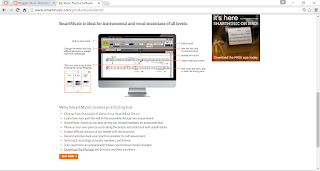Chromatik and SmartMusic seem to be fantastic and fun tools
to use inside and outside of the classroom. They can be used to enhanced the
way students practice and improve upon their skills. However, I have several
unanswered questions after my review.
Chromatik is a free web-based platform that allows students
to learn, practice, and perform music. It is also a cross platform that allows
it to be easily accessible from anywhere. Chromatik has an app available for
download through Google Play, the Apple App Store as well in Amazon Apps. This
particular feature allows you to have access to your account through a smart
phone or tablet. This resource would be
an asset in the classroom; you can access sheet music and videos for different
genres with just the click of a button. The music catalog is updated regularly.
There are over 20 different instruments
to choose from (see the screenshot below). Overall, the website and application
are very easy to use. Once you select a song and choose an instrument. However,
learning how to play the sheet music you choose is the only benefit of
Chromatik. After some review of the program, I noticed that you don’t get any
immediate feedback to improve upon your musicianship. You may record your
performance and send it to your teacher where he or she can grade it. This would be a great to challenge those
students who are advanced, but assist others in building tone quality, balance
and blend, and success in reading those tough rhythmic patterns.

On the other hand, I have a very limited scope of
SmartMusic. Unlike Chromatik, SmartMusic (software) is not free making it a
little difficult to implement within the classroom. I am not really aware of
the ease of use and navigation considering, I do not have a subscription. The
features it does offer would be the best fit for my classrooms. SmartMusic can
enhance your music programs and improve individual student skill. With a
subscription, you can assign students material from a method book or piece you
may be performing for a concert festival. Using these assignments, the student’s
practice times are more focused, and you can track their progress. What I really
like about this program is the instantaneous feedback. As you are practice, it
allows you to hear your performance and see incorrect and correct pitches and
rhythms. The students would have their own personal tutor at home and in the
practice rooms.
There is one other feature that I love about SmartMusic is
MakeMusic University. All educators need re-certification hours to renew their
teaching certificate. MakeMusic provides classes and professional developments
specifically for our area that you can use towards those hours. And the great
part about it all of this is that it is not very expensive. I was not aware. This program is the total
package, and a must-have for my program.

